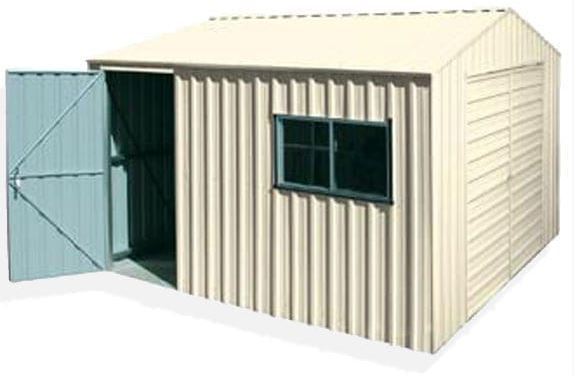7 Top Tips for Perfect Shed Positioning
Before buying a steel shed. Here are 7 top tips for perfect positioning of your shed. You want a high quality, custom made shed, and you are expecting to make a reasonably big investment. The better the quality of the materials that are used to make the shed and the better the design, the longer it’s going to last.
You do not want to buy a cheap shed made from imported mild steel for two reasons: –
- It is highly unlikely that a mild steel construction will satisfy our Australian Standards.
- It is unlikely that the materials used will have any more than a 10–15-year warranty. Quality Australian Colorbond can have a warranty of up to 35 years.
The longevity of your shed doesn’t only depend on the materials used and the design. There are also a host of on-site factors that can have a significant impact. Here’s what you need to know about where to put your shed to get the most out of it according to Professional Choice Sheds.
(1) Ease of installation and Quality of your shed – 7 Top Tips for Perfect Shed Positioning
Your best starting point here is to get a quote from Professional Choice Sheds. While this may not be the final quote you accept, you will find that it is the quote you can use to compare with all other quotes. Professional Choice Sheds are one of the very few suppliers who deliver a shed which is up to all Australian Standards. Their quote will show you how to ‘test’ all other quotes to ensure you are buying a quality shed. Also, their state-of-the-art plans and engineering drawings make for easy installation, complete with Q-Reader videos making installation quick and easy with no down time.
(2) Gradients and Slopes – 7 Top Tips for Perfect Shed Positioning
It is possible to install a shed on a steep slope or gradient. But it’s likely to cost more to lay a concrete foundation for it. If you don’t do this, or it’s not done properly, then there is a risk of the shed lifting in high winds causing severe damage over a relatively short time. The steel frame can buckle, and roller doors may not open.
It is always best to choose a place that is as level as possible. This will cut down on the preparation work necessary and usually offer a better foundation for your shed. Slopes and gradients are not ideal because they can make it harder to access the shed on foot or by vehicle. You can work around slopes if you absolutely must but try and choose a site that is as level as possible.
(3) Council Regulations
Most local councils have regulations about building setbacks. If your shed is more than nine square metres, you will probably need permission to build. Also, you need to check any height limitations. Usually there is a strip of land around the edge of any property that you’re not allowed to build on. In many cases this is as little as 500mm from a neighbour’s fence line.
In some cases, you can apply for an exception or a variance, but this can take a lot of time and the outcome is not guaranteed. It’s far better to work within the regulated setbacks when positioning your shed. A quick phone call to your local council will give you your guidelines.
(4) Access Issues
Think about the direction of any swing of doors, and make sure there are no slopes that might catch them outside of the shed. In most cases you will probably opt for a roller door so this may not be so important. If your shed is going to have a door for vehicle access, you need to take a turning circle for vehicles into account for easy egress and exit.
Look at other site features like trees, plants, and walls. If there is anything in the way of your shed’s doors, windows, or openings, think about exactly where you would like these placed. There is always the option of having skylights by using a couple of polycarbonate sheets on the roof.
(5) Aesthetics – How does it look for your neighbours?
You might be very happy with the way your new shed looks, but will your neighbours? Your shed should not block their view or light getting into their area. If it does, they might not be too impressed. Consider what your neighbours will see when the shed is installed and if you can, discuss the positioning with them. Show them your plans so they know what to expect.
You may like to consider a well-placed decorative screen, fence, or hedge? These can take the soften the view towards your shed and may keep them happier.
(6) Existing Services – Drains, Phones and Electricity
Sometimes, there are services underground that you must consider. The perfect spot for a new shed may not be permitted because it is on top of cables or pipes that may need access at some time in the future. There are services which you cannot ‘block’ with a new structure.
Existing services, plumbing and water access points, certain types of electrical or telecommunications equipment may also be important to have close by if you want these services in your shed. Certainly, it is good to be close to a pipe you can connect your downpipes to without having to dig long trenches on your property. Take time to look for visible services like manholes or water meters and consider doing a little investigating to make sure there’s nothing important under the ground in that area and consider how you may be able to connect to these services if necessary…
(7) Soil Type and Density
Before you lay your concrete slab, it may be important to have your soil tested. Most urban properties will have dense soil and it will be suitable for a concrete slab. If there is any doubt, consult a professional. Most local concreters will also be able to help here.
Imported fill material and compaction can fix soil most soil problems but this can add to your budget. The type of soil, underground water and other things can have an impact on this.
Further Reading – Click the title to read more)
Farm Sheds For Sale – Know what you are buying, how to test any quote

1 Comment